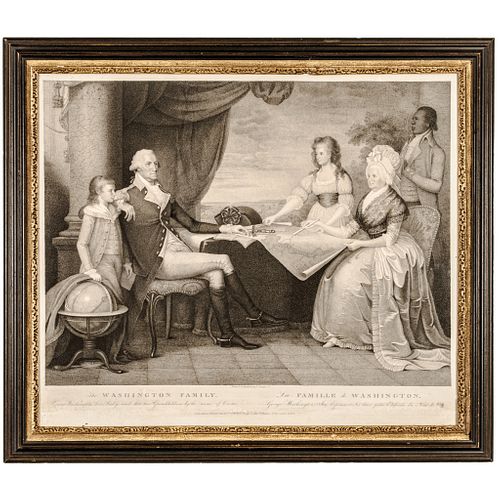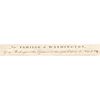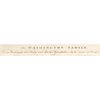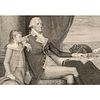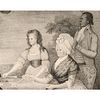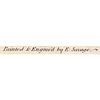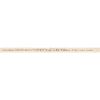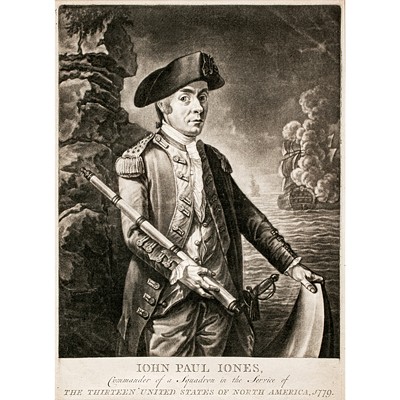1798 Print: THE WASHINGTON FAMILY by Edward Savage, Framed Extremely Fine
Lot 134
Categories
Estimate:
$800 - $1,600
Absentee vs Live bid
Two ways to bid:
- Leave a max absentee bid and the platform will bid on your behalf up to your maximum bid during the live auction.
- Bid live during the auction and your bids will be submitted real-time to the auctioneer.
Bid Increments
| Price | Bid Increment |
|---|---|
| $0 | $10 |
| $200 | $20 |
| $300 | $25 |
| $500 | $50 |
| $1,000 | $100 |
| $2,000 | $200 |
| $3,000 | $250 |
| $5,000 | $500 |
| $10,000 | $1,000 |
| $20,000 | $2,000 |
| $30,000 | $2,500 |
| $50,000 | $5,000 |
| $100,000 | $10,000 |
| $200,000 | $20,000 |
| $300,000 | $25,000 |
| $500,000 | $50,000 |
About Auction
By Early American History Auctions
Jan 23, 2021
Set Reminder
2021-01-23 12:00:00
2021-01-23 12:00:00
America/New_York
Bidsquare
Bidsquare : Early American History Auction of Autographs, Americana, Political & Maps
https://www.bidsquare.com/auctions/early-american-history-auctions/early-american-history-auction-of-autographs-americana-political-maps-6311
311 Lots of Rare, Historic Autographs, Americana, Civil War Era, George Washington, Abraham Lincoln, Slavery & Black History, Revolutionary War Era, Colonial America, Federal Period, War of 1812, Colonial Currency, Indian Peace Medals & more... Early American History Auctions auctions@earlyamerican.com
311 Lots of Rare, Historic Autographs, Americana, Civil War Era, George Washington, Abraham Lincoln, Slavery & Black History, Revolutionary War Era, Colonial America, Federal Period, War of 1812, Colonial Currency, Indian Peace Medals & more... Early American History Auctions auctions@earlyamerican.com
- Lot Description
Washington Related
Edward Savage's 1798 Print of George Washington's Family titled "THE WASHINGTON FAMILY" Framed
1798-Dated Federal Period, Handsome Engraved Print titled, "THE WASHINGTON FAMILY", by Edward Savage, Famed, Choice Extremely Fine.
This large, beautifully detailed Engraved Print measures 18.5" x 24.5" (by sight) under glass in an impressive, two-tone dark and gold gilt wood frame measuring 25.5" x 29.5" overall, framed by The Old Print Shop in New York City in May 1966. Produced in 1798 by Edward Savage (1761-1817), who favored George Washington in a number of his different artworks. This engraving shows a most distinguished President Washington in his long coat with frilled epaulets, seated facing right, with his wife Martha at right, looking over a map that appears to be a plan of the future Washington, DC at the junction of the Potomac and Eastern Rivers. Also included in the picture are Martha's grandson and granddaughter from the Custis line. In a less conspicuous position at far right is a finely attired, black servant. There are multiple interesting details in this print: Washington's sword resting atop Martha's map, his hat with a large, floral adornment, Martha's folded fan used as a pointer on the map, the calipers barely visible in the grandson's hand (presumably used on the nearby globe), the many ships in the far-off background, and the spurs on Washington's calf-length boots. This historical Print is based on studies made by Savage in the early years of Washington's presidency, eventually culminating in a colorful oil painting that was copied in the print form seen here. Reportedly, Washington ordered four copies of this print, and hung one prominently in the dining room at Mount Vernon. The overall condition is excellent and the visual impression is outstanding. We note that this is the first example that we have ever offered in Early American History Auction's four plus decades-long history. A must for any George Washington enthusiast and it is ready to display.
The Washington Family by Edward Savage is a life-sized group portrait of the Washington family, including U.S. President George Washington, First Lady Martha Washington, two of her grandchildren and an enslaved servant, William Lee. The National Gallery of Art in Washington, D.C., presently displays the large painting (7 feet x 9.3 feet).
Based on life studies made early in Washington's presidency, Savage began work on the oil painting in New York City during 1789-1790 and later completed it in Philadelphia during 1795-1796. Prints were mass-produced by Savage beginning in 1798, and by John Sartain in 1840. The Library of Congress holds in its collections a print of a color engraving that Savage and Robert Wilkinson published in London in 1798.
The image was a famous one in the 19th century. Washington himself ordered four prints of Savage's engraving, hanging one in the family dining room at Mount Vernon.
The northerly direction to the left to which a magnetic compass on the base of a globe points and topographical details of the view indicate that the family is on the west bank of the Potomac River at Mount Vernon, occupying an idealized rendering of the portico that Washington designed for the house. Shown are Martha's grandson George Washington Parke Custis (called "Wash" or "Washy"), George Washington, Martha's granddaughter Eleanor Parke Custis (called "Nelly"), Martha and a black servant of uncertain identity (perhaps the enslaved Christopher Sheels, William (Billy) Lee or Austin).
With a plan of the future city of Washington in front of her, Martha Washington is, according to Savage's catalogue, "pointing with her fan to the grand avenue". Some descriptions of the painting state that the "grand avenue" is Pennsylvania Avenue. However, the broadest and most prominent "grand avenue" that the city plan illustrates has actually become the National Mall (see: L'Enfant Plan).
Holding a caliper, young George's right hand rests near the top of the globe, which lacks geographical markings. A museum's description interprets this portion of the scene as representing American hopes for rising global significance.
A researcher has found that the perspective of the painting terminates at George Washington's heart.
- Shipping Info
-
Early American provides in-house worldwide shipping. Please contact us directly if you have questions about your specific shipping requirements.
-
- Buyer's Premium



 EUR
EUR CAD
CAD AUD
AUD GBP
GBP MXN
MXN HKD
HKD CNY
CNY MYR
MYR SEK
SEK SGD
SGD CHF
CHF THB
THB